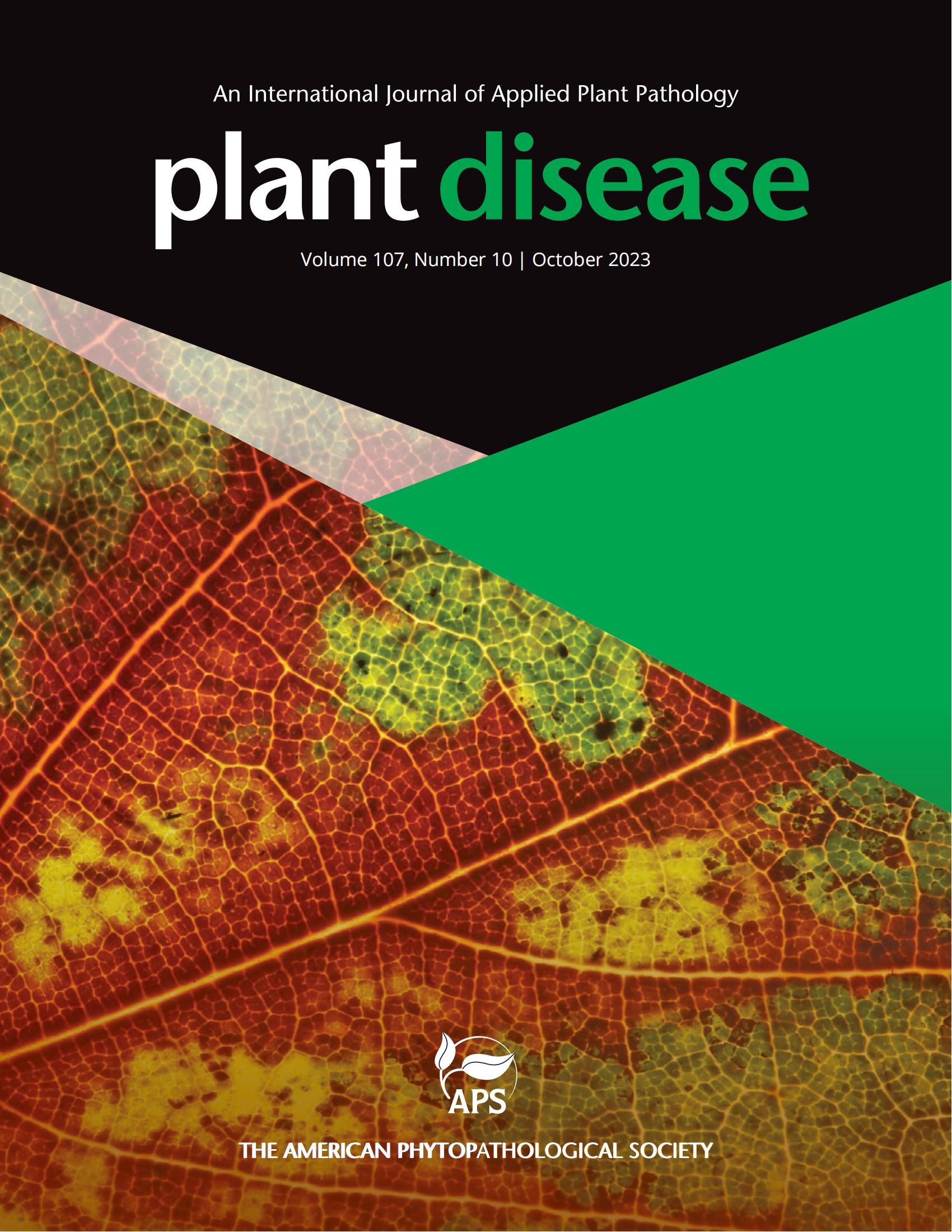中国紫花苜蓿根腐病烟草疫霉首次报道。
摘要
紫花苜蓿(俗称金花菜)是中国一种营养丰富、美味可口的饲料和蔬菜作物。2023年11月至2024年3月,在江苏省南京市(31.7960°N, 118.8902°E)某蔬菜生产基地,对多形霉进行了根腐病和叶枯病的研究。典型症状包括被水浸泡的病变,根部呈褐色至深褐色变色,以及萎蔫。随着疾病的发展,受感染的植物最终枯萎死亡。对0.75公顷多形霉地进行的调查显示,病害发病率在20%至40%之间。对有症状的根组织进行表面消毒(75%乙醇30 s, 1% NaClO 120 s,用无菌水冲洗3次),涂于10% V8琼脂上,添加50 mg/L利福平和氨苄西林,在25℃下孵育3天。分离出具有无菌菌丝的植孢子样菌落。通过菌丝尖端获得12个纯培养物(PN-1 ~ PN-12),在V8培养基上进行形态鉴定、分子鉴定和致病性检测。所有分离株的菌落都带有松散、蓬松的气生菌丝。形态学表征显示乳突状,未早落孢子囊(35-60 × 30-53µm;N =30),球形衣孢子(21-33µm;N =30),卵球形游动孢子(6-9µm;n = 30)。选择3株PN-1 ~ PN-3进行分子鉴定。rDNA的内部转录间隔区(ITS)和细胞色素c氧化酶亚基1 (COX1)基因被扩增和测序(White等,1990;Robideau et al. 2011)。ITS序列(GenBank PV077295、PV413032、PV413033)与P. nicotianae (OR342796.1、KJ494913.1、MT065865.1)的同源性为98.6% ~ 99.9%。COX1序列(GenBank PV102957、PV424230、PV424231)与P. nicotianae (MH760233.1、MT216343.1)的同源性为99.9 ~ 100%。采用菌丝琼脂栓接种法确定了烟草假单胞菌PN-1 ~ PN-3的致病性。简单地说,将含有新鲜菌丝体的V8培养基切碎,与蛭石混合,每个锅(上直径7 cm,下直径5 cm)中加入一碟(直径9 cm)的菌丝体。作为对照,同样处理不含菌丝体的V8无菌培养基,混合到蛭石中。在三个独立的重复中对三个分离株进行了致病性试验。将多形草(品种淮扬)种子在灭菌水中浸泡12 h后,以10粒/罐的方式种植于灭菌蛭石中,并混合菌丝片。将植株置于温室中,温度为25°C,光照周期为14 h/10 h,持续14天。种子在播种后4天开始发芽。接种植株在接种10天后开始出现根腐病症状,其形态与田间观察症状一致。在对照植物中未观察到症状,而从病变中重新分离出烟草假单胞菌。据报道,P. nicotianae会引起世界各地多种作物的根腐病,包括烟草(Csinos et al. 2021)、柑橘(Xiao et al. 2023)和菠萝(Shen et al. 2013)。结果表明,烟叶假单孢菌是多形草根腐病的致病因子。据我们所知,这是第一次报道烟草假单胞菌引起多形草根腐病。该报告将有助于根据田间症状识别多形根腐病,并为该地区的疾病管理策略提供依据。Medicago polymorpha (commonly known as Jin hua cai) is a nutritious and palatable forage and vegetable crop in China. From November 2023 to March 2024, symptoms of root rot and foliage blight were observed on M. polymorpha in a vegetable production base in Nanjing (31.7960°N, 118.8902°E), Jiangsu Province, China. Typical symptoms included water-soaked lesions, brown to dark-brown discoloration of roots, and wilting. Infected plants eventually collapsed and died as the disease progressed. A survey conducted in 0.75 hectares of M. polymorpha fields revealed disease incidence ranging from 20% to 40%. Symptomatic root tissues were surface-sterilized (75% ethanol for 30 s, 1% NaClO for 120 s, rinsed thrice with sterile water), plated on 10% V8 agar amended with 50 mg/L rifampicin and ampicillin, and incubated at 25°C for 3 days. Phytophthora-like colonies with aseptate hyphae were isolated. Twelve pure cultures (PN-1 to PN-12) were obtained by hyphal tipping and grown on V8 medium for morphological characterization, molecular identification, and pathogenicity testing. All isolates produced colonies with loose, fluffy aerial mycelia. Morphological characterization revealed papillate, noncaducous sporangia (35-60 × 30-53 µm; n=30), spherical chlamydospores (21-33 µm; n=30), and ovoid zoospores (6-9 µm; n=30). Three isolates (PN-1 to PN-3) were selected for molecular identification. The internal transcribed spacer (ITS) region of rDNA and the cytochrome c oxidase subunit 1 (COX1) gene were amplified and sequenced (White et al. 1990; Robideau et al. 2011). ITS sequences (GenBank PV077295, PV413032, PV413033) showed 98.6-99.9% identity with P. nicotianae (OR342796.1, KJ494913.1, MT065865.1). COX1 sequences (GenBank PV102957, PV424230, PV424231) matched P. nicotianae (MH760233.1, MT216343.1) with 99.9-100% identity. Pathogenicity of P. nicotianae (PN-1 to PN-3) was confirmed using the mycelial agar plug inoculation method. Briefly, V8 medium containing fresh mycelium was chopped and mixed with vermiculite, and one dish (9 cm diameter) of the mycelium was added to each pot (7 cm upper diameter, 5 cm lower diameter). As a control, sterile V8 medium without mycelium was similarly processed and mixed into vermiculite. Pathogenicity tests for each of the three isolates were conducted in three independent replicates. Seeds of M. polymorpha (cultivar Huaiyang) were soaked in sterilized water for 12 h and then planted in sterilized vermiculite mixed with mycelial pieces (10 seeds/pot). Plants were maintained in a greenhouse at 25°C under a 14 h/10 h light/dark cycle for 14 days. Seed germination commenced four days after planting. Inoculated plants began to exhibit root rot symptoms 10 days post-inoculation, which were morphologically consistent with field-observed symptoms. P. nicotianae was re-isolated from the lesions, while no symptoms were observed in control plants. P. nicotianae has been reported to cause root rot in various crops worldwide, including tobacco (Csinos et al. 2021), citrus (Xiao et al. 2023) and pineapple (Shen et al. 2013). Our results confirm that P. nicotianae is the causal agent of root rot on M. polymorpha. To our knowledge, this is the first report of P. nicotianae causing root rot on M. polymorpha. This report will help identify M. polymorpha root rot disease based on field symptoms and provide a basis for disease management strategies in the region.

 求助内容:
求助内容: 应助结果提醒方式:
应助结果提醒方式:


